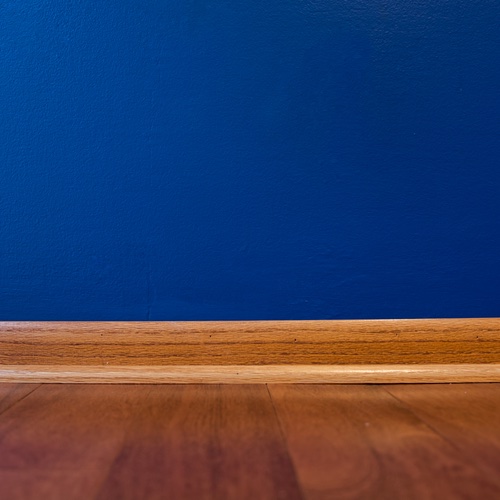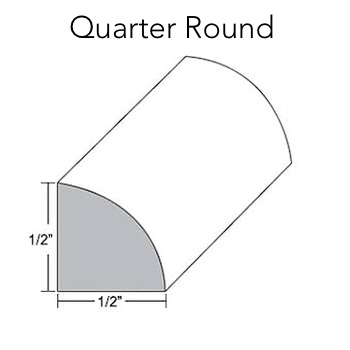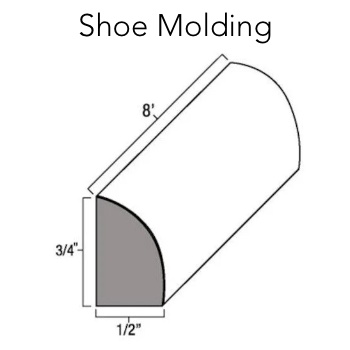
What’s the difference between shoe molding and quarter round? Aren’t they essentially the same thing?
Yes and no. Shoe molding and quarter round are like kissing cousins. They’re are almost identical. They can be used interchangeably in some cases, but they have their own specific uses as well, and I’ll explain below.
What is Quarter Round?

Quarter round is exactly as its name implies, one quarter of a round dowel. A 90° angel is cut on the backside with a perfect quarter radius on the showing side. It works great to fill corners or soften any 90° joint between trim and moldings.
Quarter round is the ultimate filler strip because it comes in a variety of sizes for almost any application. Most commonly sizes run from 1/2” to 1” with 3/4” being most popular due to its goldy-locks versatility. Here are some of the most common uses for quarter round:
- Inside corners on wall panels
- Outside corners on trim
- A substitute for shoe molding
- As part of built up moldings (crown molding, cornice, etc.)
- Fireplace mantels
- Column bases
What is Shoe Molding?

Shoe molding is much the same as quarter round, having the same 90° angle on the backside but instead of being a perfect quarter radius its profile is a bit taller than it is wide.
The main use for shoe molding is to run along the intersection of the baseboard and floor. This is what it was designed for, hence the name “shoe” inferring it’s at the foot of the wall.
Both products provide a great way to seal the gap between baseboards and the finish floor. These both also provide a good way to hide un-level floors without the hassle of scribing baseboards to match the finish floor which can be a time intensive process.
Which Should I Use?
For baseboards my first choice is always shoe molding unless some of the reasons I’ll discuss below are present. Shoes molding works best and doesn’t give a feeling of intruding into the space. Most commonly you’ll find shoe molding installed overtop of solid hardwood floors and engineered wood floors. It can be used successfully overtop of tile as well. Anywhere that you have a small gap between the wall and the edge of the finish floor.
Quarter round on the other hand works best if there is a large gap between the edge of the flooring and the walls as is commonly found in floating floors. Sometimes you’re stuck with a floor that has a large gap regardless of the style, and in that case you will need either a thicker baseboard or quarter round.
Can you mix and match throughout a house? It’s best to keep things consistent if at all possible, but sometimes if different rooms have different flooring then using a combination of quarter round and shoe molding may be necessary. However, avoid using both in the same room otherwise you’ll end up with poor fitting joints due to the discrepancies in the size and profile.
Installation Tips
I’ve installed my share of both shoe molding and baseboard and there are some tips I feel everyone needs to know that are often missed when DIYers install their own.
Tip #1 Nail Through the Baseboard Not the Flooring
Most importantly, do NOT nail your shoe molding or quarter round through the flooring. It was designed to be nailed into the baseboard which allows the flooring to expand and contract with conditions.
Using a 18 ga. nailer I prefer to shoot the nails very close to horizontal to make sure I hit the baseboard rather than nailing through the gap between the baseboard and flooring. It’s easier to nail this way for shoe molding than for quarter round.
Tip #2 Caulk the Top Not the Bottom
Once installed, caulk the top joint between your molding and the baseboard, but do not caulk the joint between the molding and the flooring even if you have an uneven flooring material like a natural stone tile.
This will, again, allow for free movement of the flooring and keep the baseboard and shoe molding as one solid unit. I’ve seen caulk squished out from below shoe molding or quarter round when the flooring swells in the summer and it’s not pretty.
Tip #3 Cope Inside Joints
For outside joints you should cut miters, but inside joints perform best with a cope joint. This is because on walls that aren’t a perfect 90º angle (honestly, are there any walls like that?) a cope joint hides the joint better and doesn’t open up like a miter joint can with flooring movement.
If you’re not sure how to cut copes on trim, shoe molding and quarter round are the easiest style to learn on. This post will teach you how any DIYer can learn to cope like a pro.
Tip #4 Avoid MDF
MDF is the cheapest option for any trim and it’s because it’s essentially sawdust glued together. Your floors get a lot of traffic and water exposure which is the mortal enemy of MDF. Floors get wet feet, mops, spills, and children’s showers constantly beating them up and when you install MDF shoe molding it fails early and often.
You end up with moldings that are softer and more prone to damage from traffic. They swell when they get wet or even when humidity levels get too high for long. For most locations solid wood is a much better option. There are also PVC options if you must for wet areas like bathrooms, but wood is my preference for anywhere really.
I hope this gives you a better understanding of shoe molding and quarter round and how to use either successfully in your house. Do you have a preference of which you prefer? Let me know in the comments below.
Subscribe Now For Your FREE eBook!

Founder & Editor-in-Chief
I love old houses, working with my hands, and teaching others the excitment of doing it yourself! Everything is teachable if you only give it the chance.


We just had a basement finished. Concrete floors and walls, 14 yrs. old, good shape. Had vinyl plank floor installed, 6″ flat trim board installed. Now trying to figure out if we should put shoe molding down.
If you have gaps and see space between your floor and wall base molding you should use it, otherwise its ok to go with out it, my final thought on it Is shoe molding add a finish touch that is not always require, it all depends on personal preferences and home style design, in most modern design the shoe molding is totally obsoleted
I had a laminate floor installed where I used to have a thick shag carpeting. The store ordered 1/4″ round but the trim is too high up. I need a 1 1/4″ round. What can I do instead of replacing the trim?
Sharon,
I am in the same boat, did you find a solution here? I am considering installing plinth blocks.
Good Post. Your blog is very informative for us. I would really like to come back again right here for likewise good articles or blog posts. Thanks for sharing a nice information…if you need the best quality rubber moulds for paver, please contact JR Rubber Industries for interlocking brick mold
For the smallest transition to a hardwood from a stone floor, What is best molding choice?
He must have been talking about cove molding, which I haven’t personally seen used there, but its a big world.
Had some laminate flooring installed — the installers left too much space on each end where the flooring is supposed to be about 1/4″ away from the wall to leave room for expansion & contraction. They left about 1/2″ on EACH end–but not uniformly. Anyway, tried using quarter round to cover the too large gaps at the edges but the quarter round is not wide enough and some gaps still show — and are ugly. Some are especially noticeable because they are very near the doorway and there is not enough room to put furniture there to hide it.
I really don’t want to pull off all the base molding and get something wider because then it won’t match any of the other rooms in the house and it’s too expensive to re-do all the base molding in the house.
Anybody have any ideas or suggestions?
THANKS!
1/2in Cove Base moulding
I use latex caulking that is close to the floor color to fill any small gaps in the flooring against the baseboard. Hides it nicely.
Would shoe molding look good on the edge of a plywood countertop?
We are refinishing 90 year old red oak strip floors in our new house and the previous owners installed quarter round around the baseboards. There are still many places where there is a gap between the floor edge and the baseboard in front of the quarter round trim piece. What is the appropriate trim solution for this?
I would like to know the answer to Jane’s question as well. We had the same problem with some tile that was installed..
My wife and I went to a custom mill shop that had door stops with different profiles. Because the door stop is “taller” than typical quarter round it covered our gap.
Hi Jane, I am not a professional, but I would build out the existing baseboard by installing a shorter mdf baseboard. Then, reattach the shoe molding to the shorter mdf baseboard. Make sure to get the correct with to cover the gaps where the flooring meets the baseboard and shoe molding. Then, spackle and paint.